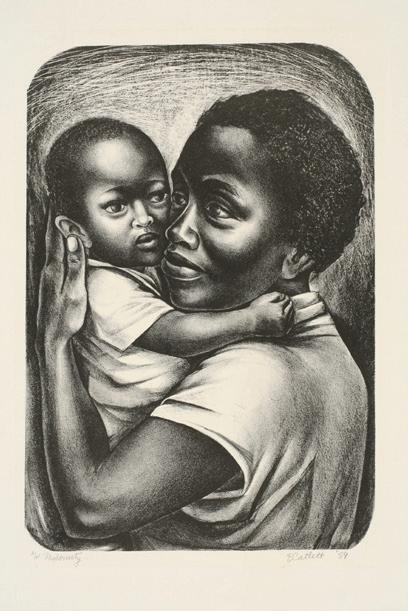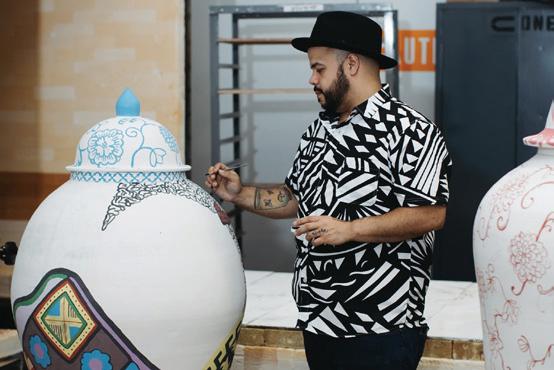
9 minute read
MY MUSEUM Inspiring Future Generations
Inspiring Future Generations
Where cranes, backhoes, and scaffolding now stand, Craig (75JD) and Nancy Willis (77BA, 80JD) see a future Iowa landmark that will inspire new generations of art lovers.
The longtime university benefactors and Iowa City community leaders have committed $1 million toward the building campaign for the forthcoming University of Iowa Stanley Museum of Art, which is set to open in 2022. The project broke ground in 2019 near the corner of Burlington and Front streets, adjacent to the UI Main Library and Gibson Square. In recognition of the Willises’ support, the plaza entrance of the museum will be named for the couple.
“We’ve really developed an appreciation for art as a result of our relationship with the institution, the collection, and the people at the museum,” says Nancy Willis. “This is an opportunity for us to express our appreciation for that enrichment.”
The Willises have become two of the museum’s most steadfast supporters since first getting involved with the organization in the 1970s. The couple, who work as real estate attorneys, have served prominent roles on numerous boards and committees for the museum, in addition to showing support for Hancher, the Iowa Writers’ Workshop, and UI Health Care, among many other university and community
organizations. This past fall, the UI presented the Willises with its top honor—a Distinguished Alumni Award for their outstanding contributions to he university.
Inspiring Future Generations

The couple credits the university for sparking their lifelong passion for the visual arts—first as museum patrons, then as art collectors themselves. Over the years, they have built relationships with art dealers they’ve met through the UI and visited many of the world’s top art galleries. They say their travels have only deepened their appreciation for the university’s cultural offerings.
“The pieces in the university’s collection are, in a way, old friends,” says Craig Willis. “And it will be nice to be able to visit those old friends again. We’re also excited about new acquisitions and traveling shows, which will be another great aspect of the new museum.”
Raised on a farm in northwest Iowa, Nancy Willis says her first exposure to the art world, like many students, happened at the UI. She’s hopeful that the museum and its accessible location in the heart of campus will spark the same interest for the next generation.
“We’re establishing a venue that will expand horizons, expand the way we look at things, and expand life experiences,” Nancy says. “This will be something that students will take with them wherever they go around the world.”
Summoned Mother
The weeks of protest following George Floyd’s killing further cast light on the prior killings of Ahmaud Arbery and Breonna Taylor and have kindled a necessary American reckoning with systemic racism. Across the country institutions are engaging in vital exercises of self-reflection and goalsetting, out of which they hope to effect lasting change.
At the Stanley, we are committed to being at the forefront of this lasting change, and we continue to identify meaningful ways to achieve this goal.

On June 19, S ummoned Mother, a threevolume video series featuring literary artist Dr. Tameka Cage Conley (18MFA), launched on the museum’s social media platforms. In Summoned Mother Conley juxtaposes the works of Elizabeth Catlett with those of contemporary Black poets Lucille Clifton, Danez Smith, Terrance Hayes, and Jericho Brown, bridging the visual and literary arts in a meditation on Black artistry’s longstanding eye on injustice.
Dr. Tameka Cage Conley Photo by Christopher Hunter
Summoned Mother
The title Summoned Mother invokes the breathless call George Floyd made for his mother while a white police officer kneeled on his neck and killed him. In each video, Conley, mother to a six-year-old Black boy, answers Floyd’s call. As Conley puts it, “Kadiatou Diallo, mother of Amadou Diallo, said, ‘Every mother heard him. We heard George Floyd. We hear him.’ I heard him.” And in response Conley created a memoir about her particular American motherhood: Black and uniquely precarious.
Summoned Mother is part of the Stanley’s revitalized dedication to amplifying the voices of artists and thinkers from underrepresented communities. We seek to create transformational educational spaces by making the museum’s resources available to diverse voices. It is our hope that this and other efforts galvanize equity and social change in Iowa City and beyond. Additionally, as believers in the restorative power of art, we aim to provide spaces for healing. “Casting my voice here for Summoned Mother, as well as my pain,” Conley says, “is something I needed.”
Elizabeth Catlett (American and Mexican, 1915–2012) Maternity, 1959, Lithograph, 23 x 17 1/2 in. Museum purchase, 2006.70 © 2020 Catlett Mora Family Trust / Licensed by VAGA at Artists Rights Society (ARS), NY View all three volumes of Summoned Mother on the University of Iowa Stanley Museum of Art YouTube channel

Public Programs

Roberto Lugo, the first ceramic artist to receive the Rome Prize, will deliver the Spriestersbach lecture by video in October.

While the Stanley Visual Classroom remains closed to mitigate the spread of COVID-19, we are happy to continue our Saturdays at the Stanley, smART Talks, and annual Spriestersbach lecture, all online, along with new programs we’ll be launching on Zoom. The Stanley is able to continue and expand its virtual programming in 2020–21 thanks to Yvonne McCabe’s generous support.
In October Roberto Lugo will deliver the Spriestersbach lecture by video. Lugo, the first ceramic artist to receive the Rome Prize, spent the last year living and producing work in Rome, Italy. He is known for injecting contemporary social justice issues into traditional ceramic forms. For example, he added a gun barrel from a gun buyback program in New Jersey and an image of Tupac Shakur to a teapot ( To Disarm: Tupak, 2019). About the teapot, he said, “When I make a teapot, I’m thinking about the accessibility of that particular vessel.” He adds portraits, like the one of Tupac, to his objects “to look at history and re-contextualize the ceramic vessel.” Lugo will discuss other key aspects of his work in this year’s virtual Spriestersbach lecture.
Saturdays at the Stanley will kick off on September 12 with Cory Gundlach, curator of the arts of Africa, Oceania, and the Americas, who will discuss his exhibition Follow Her Lead. The exhibition highlights the strength of our collection of African and Diaspora art and focuses
on women, motherhood, fashion, and leadership across times and cultures. On October 12, Brady Plunger, associate curator of education, will examine how artists’ movements across geographical, cultural, and political landscapes resonate through their work in a talk titled “Artists, Travelers, & Immigrants.” We will conclude our fall series on November 7 with “Frenemies: Jackson Pollock and Willem de Kooning” led by Kimberly Datchuk, curator of learning & engagement. The discussion will focus on the breakthroughs each artist made in abstract painting and how their friendship and rivalry bled into (and fed) their art. The online platform will be especially useful for this talk because it will allow us to look very closely at the surface of Pollock’s Mural and Portrait of H.M., as well as consider key paintings by de Kooning not in the Stanley’s collection.
In addition to resuming Saturdays at the Stanley, we have some new programs we will introduce on Zoom. Stanley Reads, a book club presented in partnership with Prairie Lights Books, will meet virtually every two weeks for a total of six meetings. Our first read, starting in the fall will be Homegoing, the debut novel of Yaa Gyasi, a graduate of the Iowa Writers’ Workshop. Homegoing was published in 2016 by Penguin Random House and won the PEN/Hemingway award. The novel spans from the eighteenth century to present day and from Africa to America, as it follows the parallel paths of two sisters and their descendants through eight generations. As part of the discussion, Kimberly Datchuk will pair chapters of the book with pieces from Follow Her Lead to highlight overlapping themes and to examine the characters, histories, and artwork more deeply.
For the family, we will offer two art-making workshops through our Stanley Creates programing. Lauren Linahon, a graduate student in art education in the UI College of Education, will lead kids and their parents through art projects that relate to our recent exhibitions in the Stanley Visual Classroom— Follow Her Lead,20/20, and Fluidity—using materials readily available at home. The projects are geared toward elementary and middle school students, but everyone is welcome to join.
Lastly, we will have a trivia night, Stanley Quiz Show, hosted by Brady Plunger on October 20. (Virtually) gather your friends to compete as a team for bragging rights. Questions will focus on artists and artistic movements, as well as general museum history. These three events— Stanley Reads, Stanley Creates, and Stanley Quiz Show—are free, but require registration online for planning purposes.
We look forward to meeting with you virtually throughout the fall. Thank you for joining us as our online adventure continues!

Reese Lensing

Produce N Van Gogh


Deborah Elizabeth Whaley
The Virtual Museum & The Classroom
In response to the pandemic the Learning & Engagement department has been shifting the ways they connect with their audiences. When UI classes went online for the remainder of the spring semester, they shared the collection digitally with faculty and students through virtual visits. They’ve also been developing content in collaboration with the other departments at the Stanley so the rest of you can “Museum from Home”—including coloring sheets based on the museum’s collections, familyfriendly activities, DIY art projects, and behind-the-scenes videos, all of which are available free on our website.
As they look toward the fall, the L&E team is excitedly preparing to meet virtually with K–12 and university students, senior living communities (SLC), and the public. Associate Curators of Education Brady Plunger and Joshua Siefken are preparing instructional videos about some of our Stanley School Programs Collections: these will feature Graphic Novels and Comic Art, Masks, Art of Africa, and American Indian and First Peoples’ Art. Curator of Learning & Engagement Kimberly Datchuk is producing additional videos and digital resources, such as worksheets and discussion guides, to help faculty teach with the Stanley’s collection whether they plan to teach face-to-face or online. Senior Living Coordinator Amanda Lensing has been writing biweekly newsletters since March to continue sharing art with some of the communities hit hardest by COVID-19. In partnership with SLC activities leaders, she is also developing virtual programs for the fall to keep seniors connected to the museum and each other.
The L&E team is eager to meet the challenge of this difficult time. The Stanley’s education programs will continue to evolve in conversation with faculty, teachers, and senior living communities, so everyone can stay engaged across a variety of platforms in new, accessible, and innovative ways.




